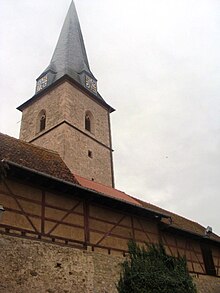St. Sigismund (Zeilitzheim)
The church of St. Sigismund in Zeilitzheim in Lower Franconia is the center of the Protestant community. It forms a fortified church with the surrounding Gaden . The church is on the market square in the Kolitzheim district. It belongs to the Deanery of Castell .
history
Origins (until 1566)
The history of the parish in Zeilitzheim is closely linked to that of the nearby Herlheim . As early as the 13th century, Zeilitzheim was a branch of the Jakobuskirche in the neighboring village. From this it can be concluded that when Zeilitzheim was first mentioned in 1278, a small chapel must already have existed. The location of this church has not been clarified, but it is certain that the church must have been in a different location than the one today.
In 1328 Zeilitzheim was parish from Herlheim and itself the seat of a pastor. The reason was a foundation by the village master Friedrich von Grumbach . The first pastor, however, was only mentioned in 1423 with Hans Weiß. A year later, in 1424, Wilhelm von Grumbach created a second pastorate that lasted until the Reformation . By 1451 the church was moved to its current location and placed under the patronage of St. Sigismund .
The Reformation in Zeilitzheim was associated with the noble Argula von Grumbach . In 1516 she married the village master Wilhelm von Grumbach and from then on spent a lot of time in the castle in the village. The close contact that she had with the reformer Martin Luther also brought Protestant ideas to the town. From 1530 Argula lived permanently in the castle. In the years 1521 and 1527 the vicar Jakob Pfeffer preached in Zeilitzheim.
The Evangelical Parish (until today)
The new denomination was finally established until 1566. The first Protestant pastor was Melchior Hemmel, who is documented in 1574. In the course of the Counter-Reformation , the troops of the Catholic Bishop Julius Echter von Mespelbrunn advanced against the Protestant communities in the area, but they only got as far as the Zeilitzheim local border. The Thirty Years' War caused far more devastation. The village suffered from many raids and looting.
At times in the following years the church was used as a simultaneous church for both denominations. This situation only changed when a small, Catholic chapel was established in the castle. The coexistence of the different faiths was made difficult by the fact that the Protestants continued to use the Julian calendar for their holidays, while the Catholics had introduced the Gregorian calendar.
In the 19th century the community experienced a further appreciation: the district churches and school inspection were relocated to Zeilitzheim and the place was effectively the seat of a dean. The localities Eichfeld, Krautheim, Obereisenheim, Bimbach, Eschenau, Schwebheim and Neuses am Berg belonged to the Deanery Zeilitzheim. However, the deanery was dissolved again in 1824. In the years 1848 and 1855, the Zeilitzheim conferences for the reorientation of the Bavarian Church took place there.
The crises of the 20th century also affected the church in Zeilitzheim. From 1934 the community was part of the Confessing Church and survived the Nazi era . In 1969 the church received an electric bell. Renovations to the building were made in 1960, 1971 and 1980 to 1983. The Bavarian State Office for Monument Preservation classifies the building as a monument. Underground remains are listed as a ground monument , the church is part of the Marktplatz ensemble.
architecture
The church is a choir tower church. It is an east-facing hall church. The west portal is equipped with late Gothic fittings. The tower was completed in 1451 as the last component, it has three floors, which are externally recognizable by cornices . A pointed helmet closes it off at the top. The nave with a flat ceiling is illuminated by three rectangular windows. The choir is equipped with a rib cross vault.
Furnishing
Wooden ceiling
The most important piece of equipment in terms of art history is the brightly painted wooden coffered ceiling. A flat ceiling was drawn in when the nave was erected in the 15th century. In the 17th century the church received its current wooden ceiling, but the paintings, which were carried out by an unknown artist in the years after 1700, were not yet available.
The most holy trinity can be seen in the center. Jesus with the cross sits next to God the Father, who holds a blue orb in his hands. The Holy Spirit, depicted as a dove, hovers over both of them. On the cassettes around this scene the apostles are shown with their names and symbols. The other coffers have baroque foliage.
Further equipment
A simple altar forms the center of the choir. A large crucifix by Karl Hemmeter came into the church in 1942. The pulpit dates from the 16th century. The font was created in 1747 and the baroque organ case was built at the same time. Two sides of the nave have galleries that were built in together with the coffered ceiling in the 17th century.
literature
- Georg Dehio : Handbook of the German art monuments. Bavaria I: Franconia . Munich and Berlin 1999.
- Rudolf Kniewasser (Ed.): Castell-Grafschaft and Dean's Office . Erlangen 1991.
- Karl Treutwein : From Abtswind to Zeilitzheim. History, sights, traditions . Volkach 1987.
Web links
Individual evidence
- ^ Kniewasser, Rudolf (Ed.): Castell. County and Deanery . P. 110.
- ^ Kniewasser, Rudolf (Ed.): Castell. County and Deanery . P. 115.
- ^ Dehio, Georg: Handbook of German art monuments . P. 1231.
- ^ Treutwein, Karl: From Abtswind to Zeilitzheim . P. 275.
Coordinates: 49 ° 53 ′ 56.5 ″ N , 10 ° 16 ′ 5.9 ″ E


